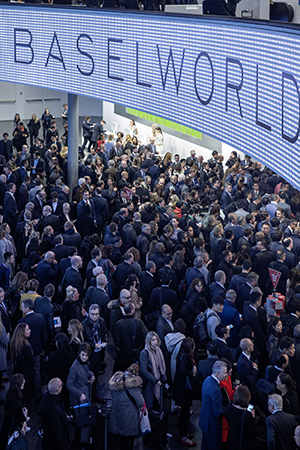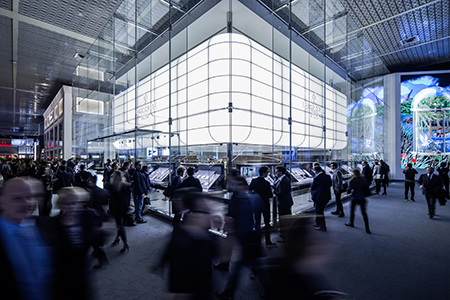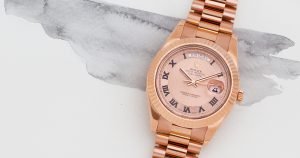Understanding Baselworld’s Downfall and Bad Rep
Five, ten years ago, Baselworld was the hotshot tradeshow.
Baselworld kicked off the tradeshow season every March and the industry became a moveable feast, going from Baselworld in Basel and then immediately onto SIHH in Geneva. Insiders would hobnob and ogle the newest collections by industry giants Rolex and Patek Philippe and prepare their store’s orders well in advance of the busy holiday shopping season. The show would be capped off with sensational and lavish parties hosted by top tier brands, the most notorious of all being Breitling’s raucous bashes.
Jump cut to Baselworld 2018.
Brands—including big names like Hermès, Girard Perregaux, Movado, Fendi, Dior and Ulysee Nardin—are pulling out left-and-right—so many in fact that the exhibitor list is half of what it was last year. Attendance is on a steady decline. And there seems to be a collective groan from guests who are wrestling with whether or not they should even bother going.
So. What the hell happened?
Why Everyone Hates Baselworld
The biggest source of the industry’s ire? The staggering price tag of attending Baselworld.
Hotels, taxis and restaurants gouge attendees with surge pricing, premium night rates and menus printed special for Basel fairgoers (read: $$$$ prix-fixe). This seasonal inflation has stirred up a lot of bitterness in attendees. The high cost also pushes out any smaller brand, reporter, or retailer who isn’t flush with cash.
But the expense isn’t really the reason why people are fleeing Baselworld; after all, people and brands were willing to spend the money to go before. The difference now is that the incentives to attend are not outweighing the increasing cost to go.
How Attendance Plummeted
Putting aside the new product releases, Baselworld’s biggest draw was that it was a networking hub. It was an important place to see and be seen, get in front of key players and try to make some deals happen. But shifts in the greater industry landscape have gradually eaten away at the networking pool.

Baselworld Entrance
First off, the global market for watches is only gradually on the rise. After two years of dwindling numbers, there is a promising uptick in sales, but brands remain only cautiously optimistic. It’s hard for the retailers to definitively declare that their trip to Baselworld was productive and a success. Brands need to be more creative with their marketing budgets on how to help effect sell-through. (Cough, digital, cough. Anyone?)
Similarly, there are simply fewer watch retailers. Retailers formerly made up a key segment of the Baselworld attendees. As authorized retailers, boutique owners went to meet with brands, learn about the new collection and to place orders. However, as more brands have gone direct-to-consumers and opened their own retail shops, they’ve forced out other independent retailers, effectively eating up that Baselworld audience segment.
Another key segment that is dwindling: financially-backed journalists. That is to say, there are fewer traditional news outlets with the big budgets to send editors to cover the show. In their place are a lot of smaller, niche outlets, websites and credible bloggers. While these publishers may have eager readers and an impressive reach, they do not necessarily have the funds to cover the cost of the trip. And, unlike SIHH where journalists are typically invited and comp’d by a brand to cover the show, that is not the case at Baselworld: journalists are largely expected to pay their way.
Also, it’s not really necessary for journalists to make the long trek out to Basel anyway. So many brands preview their collection well in advance of the show, sending out exhaustive press kits or hosting local meet-and-greets instead.
So that knocks down the retailer and the journalist guest lists. What about the brands?
Where Did All the Brands Go?
When it comes to the big-name brands’ attendance at Baselworld, it’s a matter of one-hand-washes-the-other. There are virtually no retailers they need to wow with new product. There are a handful of reporters doing on-the-ground coverage. The Baselworld-network is smaller now and there’s less of a reason for them to invest in a Baselworld booth when there are so few people to impress.

Outside the Patek Philippe Baselworld Booth
Instead, brands are finding greater success at the local level and are setting up regional shows. Hong Kong and Dubai introduced their own watch shows to great fanfare. Miami also launched Watches & Wonders this year which captured the attention of retailers and consumers.
And some brands have gone even a step further: Richemont, for example, hosted their own show in Arizona for the convenience of US-based retailers. Breitling also launched their latest collection in New York with an exclusive black tie soirée.
Meanwhile, independent brands who simply cannot afford to attend Baselworld officially take appointments in the suites of Basel’s surrounding hotels to give retailers and reporters facetime with the watchmakers and a very up-close-and-personal look at the product.
This all results in a very circuitous downward spiral for Baselworld: fewer brands mean fewer retailers mean fewer journalists mean fewer brands…
The Uncertain Future of Baselworld
This year, Baselworld lost significant ground to SIHH, an equally luxe tradeshow that has become the preferred destination for brands, retailers, and reporters. The new tradeshow darling SIHH attracted more brands this year, constructed a sophisticated campus and kept tabs on the guest list by requiring all attendees be specially invited by exhibiting brands. (Baselworld’s open-to-the-public policy, meanwhile, creates a headache for busy working show-goers who need to dodge all the looky-loos and their dogs. Seriously.)
Yes, Baselworld, could try and redeem itself by creating a digital-friendly show experience in the vein of SIHH, who decimated Baselworld in this arena with reliable WiFi and special photo booths sprinkled across the show floor so journalists could snap and share social-media friendly posts. (And, in their defense, Baselworld is offering a live stream, push notifications with show news, and even an independent app to hopefully make it easier for attendees to navigate the show—or find the bathroom, a struggle all too well-known by longtime attendees)
But all these (rather underwhelming) efforts are ultimately futile because there is no longer a need for Baselworld to exist at all.
Baselworld, for all its glitz and glamour, is, at its core, a global tradeshow. And tradeshows today are not as relevant to doing business the way they once were. Previously, you had to go to Baselworld to learn about the product and get your order so it could be delivered in another six months.
But now? Now product is previewed in January. Now retailers can place orders remotely and receive product in two months’ time. Now journalists sit on articles before the show, just waiting to push “Publish” once their embargo is lifted. Ultimately, Baselworld is a sad reflection of the industry’s reluctance to accept the changing and emerging digital landscape. It’s stuck.
Yes, the prohibitive cost of attending soured the once fun-loving atmosphere, but, it’s not a cost-per-attendee issue. It’s a cost-value proposition. No one is getting enough out of this tired show anymore; we’re all just getting more and more resentful about having to shell out more and more money to be there at all.
So, honestly, why go?







